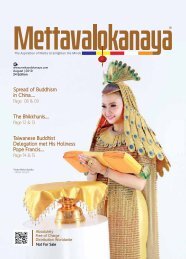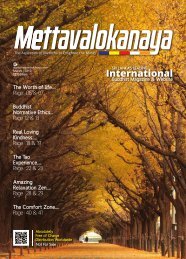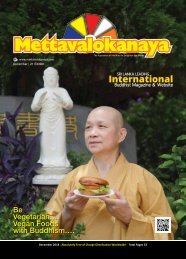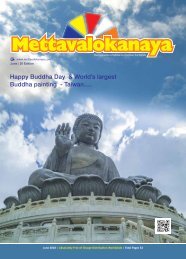mettavalokanaya_international_buddhist_magazine_december_2019
This is the Sri Lankan's Most Popular & Leading Monthly International Buddhist Magazine, “Mettavalokanaya” on December Edition - 27. “Mettavalokanaya” Buddhist Magazine has been successfully distributed to 40 countries worldwide. Specially distributed Overseas High Buddhist Monks, Masters, Nuns, Worldwide Buddhist Monasteries & Associations, International Buddhist conferences, Forums and High Commissions & Embassies situated in Sri Lanka & overseas Sri Lankan High Commissions & Embassies.
This is the Sri Lankan's Most Popular & Leading Monthly International Buddhist Magazine, “Mettavalokanaya” on December Edition - 27. “Mettavalokanaya” Buddhist Magazine has been successfully distributed to 40 countries worldwide. Specially distributed Overseas High Buddhist Monks, Masters, Nuns, Worldwide Buddhist Monasteries & Associations, International Buddhist conferences, Forums and High Commissions & Embassies situated in Sri Lanka & overseas Sri Lankan High Commissions & Embassies.
You also want an ePaper? Increase the reach of your titles
YUMPU automatically turns print PDFs into web optimized ePapers that Google loves.
Virtue
Ethics….
A
virtue is a trait or quality
deemed to be morally
excellent and thus is valued
as a foundation of principle
and good moral being. Personal virtues
are characteristics valued as promoting
individual and collective well-being.
The opposite of “virtue” is “vice”. In
Buddhist teachings, virtues that are
cited include: Generosity, Morality,
Renunciation, Transcendental Wisdom,
The Secretary General
of Taiwan Buddhist
Association, Secretary
General of the World
Buddhism Bhikkhuni
Association & the Chinese
Buddhism Bhikkhuni
Association, Abbess
of Miau Kuang Chan
Monastery.
Most Venerable
Bhikkhuni Shih Jian Yin
Taiwan
Diligence, Forbearance, Honesty,
Determination, Loving-Kindness, and
Serenity. Other virtues associated with
Buddhist traditions include: Compassion,
Enlightenment, Right understanding,
Truth, Responsibility, Simplicity, Nonviolence,
Preventing and Healing
Suffering, Harmony, Co-operation. More
specific, Buddhist practice as outlined in
the Noble Eightfold Path can be regarded
as a progressive list of virtues.
The purpose of Buddhism is not to
rise to a high status in worldly human
society; but to develop one’s own
virtues, to purify one’s heart and mind
and to awaken through or by practicing
sīla, samathi and paññā. The objectives
are: fi rst to purify oneself, to gain
wisdom, and then to help others escape
suffering. Initially, Lord Buddha taught all
His disciples – men, women, monks and
novices – the same basic concepts: the
same Four Noble Truths, the same Five
Precepts, the same Three Trainings and
the same Eightfold Path. He summarized
these in the Ovatta Patimokkha as:
“Avoid evil, do good, and
purify your heart and mind.” “Sabba
papassa akaranam, avoid all evil,
Kusalassupasampada, Cultivate the good,
Sachitta pariyodapanam, And purify your
heart. Etam Buddhanasasanam.” This is
the teaching of the Buddhas Avoiding
evil means following the Five Precepts:
avoiding killing, stealing, adultery, lying,
and intoxicants. Cultivating the good
means: practicing dana or generosity; sila
or morality; and bhavana or meditation.
Meditation is the key to purifying the
heart and mind, developing spiritual
values and living happily by discarding
defi lements (kilesa) and developing
wisdom.
Only after attracting a large group
of disciples, did Lord Buddha begin to
distinguish distinct rules with different
precepts for various groups for living
harmoniously in their diverse positions
and circumstances. Lord Buddha replied
to Venerable Ananda that women could
attain enlightenment just like men if
they practice well. Now, however, we
fi nd fi ve precepts for lay people, eight
precepts for nuns, ten for novices,
227 for bhikkhus and 331 precepts for
bhikkhunis. It sounds simple, but, it is
difficult to maintain virtue rigorously
in accordance with such rules. More
broadly, Lord Buddha also directs people
to follow the Eightfold Path in order to
live happily. One should always think, act
and speak correctly. This is easy to say,
but hard to maintain in practice. One
must overcome the hindrances. The key
underlying objectives are first to purify
yourself, developing spiritual value to be
a good person and to gain wisdom and
awaken, then extending your help to
others. Spiritual values are crucial. If one
can maintain pure spiritual values, and
awaken through wisdom acquired, one
will live contentedly. This is one’s first
duty to oneself.
Afterwards, one can extend help
to others. Worldly values stress getting
ahead, being superior and winning based
on personal desires. In contrast, the
supra-mundane values of Noble Disciples
emphasize resolution, modesty, humility
and consideration. The Buddhist path
is: training yourself to know yourself,
purifying yourself, and making yourself
into a refuge unto yourself.
“Days and nights fly past, fly past:
What am I doing right now?” - The
Buddha has you ask that question every
day, both to keep yourself from being
complacent and to remind yourself that
the practice is one of doing. Even though
we’re sitting here very still, there’s still a
doing going on in the mind. There’s the
intention to focus on the breath, the
intention to maintain that focus, and
the intention to keep watch over how
the breath and the mind are behaving.
Meditation as a whole is a doing. Even
when you practice non‐reactivity or
“being the knowing,” there’s a still an
element of intention. That’s what the
doing is.
That was one of the Buddha’s
most important insights: that even when
you’re sitting perfectly still with the
intention not to do anything, there’s still
the intention, and the intention itself is
a doing. It’s a sankhara, a fabrication.
It’s what we live with all the time. In
fact, all of our experience is based on
fabrication. The fact that you sense your
body, feelings, perceptions, thoughtconstructs,
consciousness—all of these
aggregates: To be able to experience
them in the present moment you have
to fabricate a potential into an actual
aggregate. You fabricate the potential
for form into an actual experience of
form, the potential for feeling into an
actual experience of feeling, and so on.
This element of fabrication lies in the
background all the time. It’s like the
background noise of the Big Bang, which
hums throughout the whole universe
and doesn’t go away. The element of
fabrication is always there, shaping
our experience, and it’s so consistently
present that we lose sight of it. We don’t
“Meditate is
to strip things
down”….
realize what we’re doing.
What you’re trying to do as you
meditate is to strip things down so you
can see the very elemental fabrications
going on in the mind, the kamma you’re
creating with every moment. We’re not
making the mind still simply to have a
nice restful place to be, a nice experience
of ease to soothe our stressed‐out
nerves. That may be part of it, but it’s
not the whole practice. The other part
is to see clearly what’s going on, to see
the potential of human action: What
are we doing all the time? What are
the potentials contained in this doing?
Then we apply that understanding of
human action to see how far we can go
in stripping away the unnecessary stress
and suffering that come from acting in
unskillful ways.
Goh Bee Wah
From Kaohsiung, Taiwan.
28 l Mettavalokanaya l December l 2019 l www.mettavalokanaya.com www.mettavalokanaya.com l 2019 l December l Mettavalokanaya l 29
















